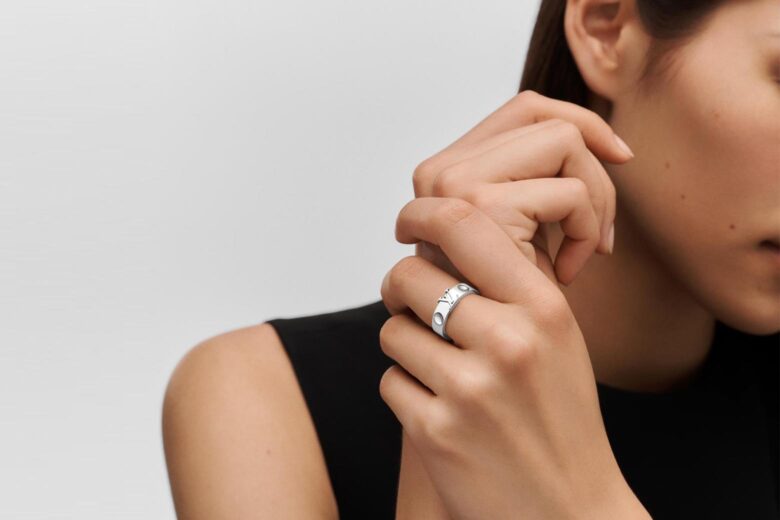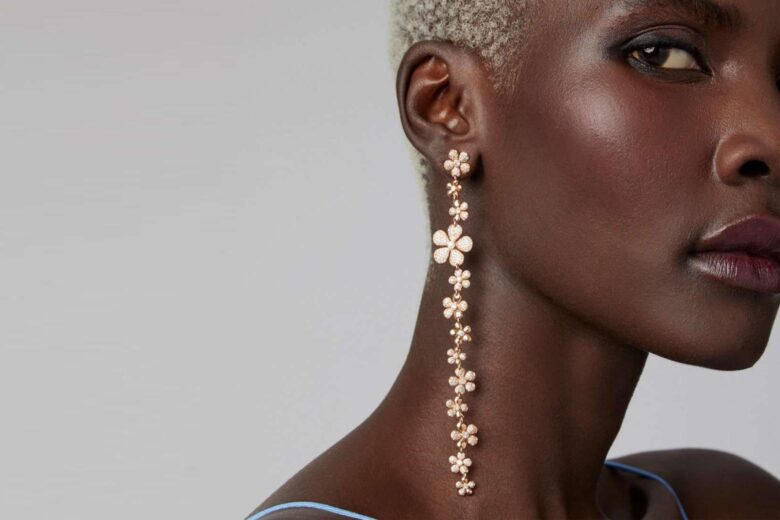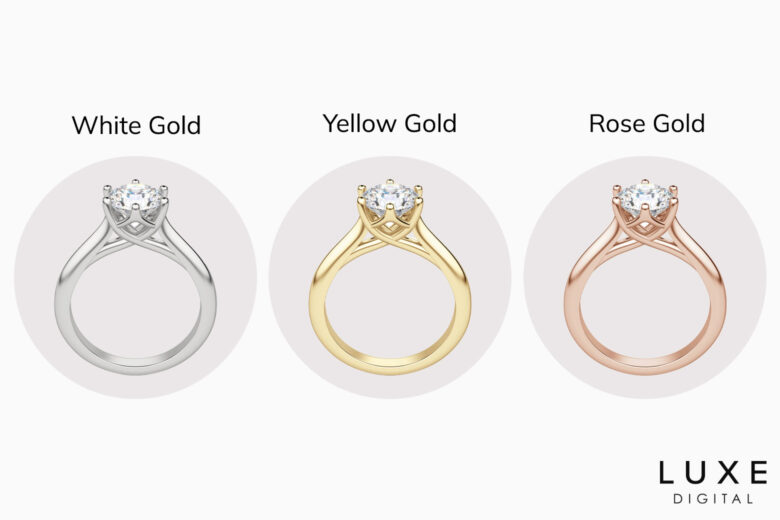Everything that glitters isn’t gold right? True, but you may be surprised by just how many types of gold there are.
From clean white golds to decadent yellows and romantic pinks, every shade of gold scintillates in its own way.
So how do you know which gold color to choose? You could wait for your grandmother to tell you which hue suits you and stick to that for the rest of your life. But where’s the fun in that? Mixing and matching metals is no longer considered taboo. In fact, it’s quite on-trend. And whilst our minimalists at heart may cringe at the thought, the rest of us see it as an excuse to adorn our jewelry organizers with every shade of gold.
Your best necklaces may all be white gold, but that just means that there’s plenty of room for yellow and rose iterations. Your best earrings may all be yellow gold, but we just see that as an opportunity to think out of the box with white and rose accessories. And your best bracelets may all be a beautiful shade of pink, so why not do something different and mix it up with yellow or white?
Made by the best jewelry brands, we appreciate the subtle distinctions between every shade of gold jewelry and prefer not to exclude one or the other from our timeless collections.
Why are some golds different colors?
All pure gold is yellow. But pure gold is usually considered to be too soft for everyday wear and most solid gold jewelry is a gold alloy or karat gold. Karat gold is made by combining pure 24K gold with various other metals. Not only do these metals strengthen the gold and make it more suitable for everyday wear, but they can also alter the hue of the precious metal.
Although karat gold isn’t 100% pure gold, it is still considered to be “real gold” if it is 9 karats or more. This means that there are many different colors of gold out there, with the most popular being yellow gold, white gold, and rose gold.
Gold colors
Not all solid gold jewelry is yellow, yet it is still considered “real gold.”

Yellow gold
All gold in its purest form is yellow, but that doesn’t mean that all yellow gold jewelry is pure. In fact, most of it isn’t. Pure gold is actually soft, making it unsuitable for everyday wear. Because of this, most quality gold jewelry is made from a gold alloy; a composition of pure gold and other strengthening metals.
These metals will alter the shade of yellow slightly, but the aim of them is to strengthen the alloy, whilst keeping its hue as similar to pure gold as possible. Ultimately, the more pure gold the precious metal contains, the richer and brighter the shade of yellow. And the less pure gold it contains, the more pale and muted it will be.

White gold
Because gold found in nature is always yellow, all white gold jewelry is made from a gold alloy. But this doesn’t make it any less real than yellow gold. Yellow gold and white gold of equal karatage will contain exactly the same percentage of pure gold. The only real difference between white gold and yellow gold is the hue, which is solely determined by what other metals are added to the pure gold.
White gold is made by mixing pure gold with white metals such as nickel, palladium, silver and platinum, changing the color of the metal from yellow to white. Once the alloy is mixed, it is usually coated with a layer of rhodium for added protection and extra scintillation.

Rose gold
Like most yellow gold and all white gold, rose gold is a type of gold alloy, containing pure gold and other metals. This means that an 18K rose gold ring will have the same amount of pure gold as an 18K yellow gold ring or an 18K white gold ring. The only difference between the composition of the three different colored rings will be what other metals have been mixed into the metal.
Rose gold is made by combining pure gold with pink metals such as copper, silver and zinc. These metals alter the precious metal’s hue from a bright yellow to a delicate pink, making rose gold a sought after alloy for romantic gifts and sentimental pieces.
Other colors of gold
Yellow gold, white gold and rose gold are the most popular gold alloys. But they aren’t the only options. The color of gold alloys is impacted by what other metals are added to pure gold. This means that a combination of alloys can be added to produce almost any hue.
While uncommon, green gold is created by combining pure gold with copper, silver and zinc (in different proportions to rose gold.) Purple gold results from mixing pure gold with aluminum. Blue gold is a mixture of pure gold, indium and iron. And black gold derives from pure gold and cobalt.

White Gold vs Yellow Gold vs Rose Gold
Most real gold jewelry is made from white gold, yellow gold or rose gold. The biggest distinction between these gold alloys is, of course, their difference in coloring, determined by the addition of various other metals. But these metals don’t just determine the color of the gold, they also impact other properties and characteristics of the precious metal.
Yellow gold is made by combining pure gold with copper, silver and zinc. Whilst copper can cause allergic reactions, very little of the metal is used (compared to rose gold) and a yellow gold alloy is generally considered to be highly hypoallergenic, especially if it has a high karatage. A higher karatage also means that the alloy is less likely to tarnish or fade and requires very little maintenance. The downside of a high karatage, is that the more pure gold the alloy contains, the softer it will be.
White gold is made by combining pure gold with white metals such as nickel, palladium, silver and platinum. It is then plated with rhodium. Nickel can be a problematic metal for people with sensitive skin, which can make white gold less hypoallergenic than other types of gold. But, if the layer of rhodium is thick enough, this shouldn’t be a problem. However, while the rhodium coating adds extra protection, it can require more maintenance, as the coating can wear off after years of heavy use and require re-plating.
Rose gold is made by combining pure gold with a lot of copper and a touch of silver and zinc. The higher percentage of copper can make the precious metal less hypoallergenic. Although for most, this isn’t a problem. On the flipside, copper is a very strong metal and is less susceptible to tarnish than other metals. This makes rose gold the most durable type of gold, requiring very little maintenance.
| Other metals | Hypoallergenic | Durability | Maintenance | |
| Yellow gold | Copper, silver and zinc | Yes | The higher the karatage, the softer it is | Low maintenance |
| White gold | Nickel, palladium, silver and platinum | Nickel can cause allergies but protected by layer of rhodium | Layer of rhodium adds extra protection | Rhodium coating can require re-plating every few years |
| Rose gold | Lots of copper with a touch of silver and zinc | Copper can be problematic | Most durable | Extremely low maintenance |
Is one gold color more valuable than the other?
Quality gold jewelry comes in many different hues. And contrary to popular belief, none is more valuable than another. The value of solid gold jewelry is determined by the purity of the gold, not by its color.
This means that the karatage of gold is what impacts its value.
Despite their differences in appearance, yellow gold, white gold and rose gold of equal karats, all contain the same percentage of pure gold. And therefore, they will all have the same value. For example, 14K white gold has exactly the same value as 14K yellow gold or 14K rose gold.
Frequently asked questions about different gold colors
There are many different colors of gold, but the most popular by far are yellow gold, rose gold and white gold. These three types of gold all contain a combination of pure gold and other metals. And all three of these types of gold are considered “real gold” despite their different colorings. Check our in-depth guide on gold colors to learn more.
It is difficult to say which is better between white gold, yellow gold and rose gold. Some consider white gold to be best for people with fairer skin tones, yellow best for people with darker skin tones and rose gold to be complimentary for all skin tones. However, these are no hard and fast rules when it comes to quality gold jewelry.
White gold, yellow gold and rose gold jewelry are all made from gold alloys; a combination of pure gold and other metals. The value of all real gold jewelry is determined by the purity of the gold, not by its color. Therefore 18K white gold should be just as valuable as 18K yellow gold or 18K rose gold.
All solid gold jewelry is made from gold alloys, whether its white gold, yellow gold or rose gold. The purity of the alloy is what determines its value, meaning that different types of gold of equal karatage should cost the same. This, however, isn’t always the case as the process used to manufacture the different types of gold can alter the price of the precious metal. The process used to coat white gold is the most costly, making white gold slightly more expensive than rose gold or yellow gold.










